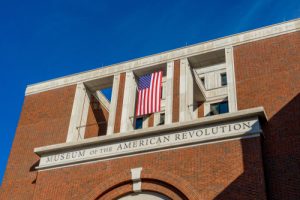Museum of the American Revolution
Philadelphia is acknowledged as the cradle of the American Revolution, so it is fitting that visitors to the city can call in at the Museum of the American Revolution.
The Museum tells the story of the Revolution through interactive exhibits and a series of fascinating displays of artifacts and documents. In addition to the permanent exhibits, there is also a program of lectures, discussions, talks, and tours. Whatever your interest in the Revolutionary period of American history there is something to appeal to you. 
What is there to see?
The galleries of the Museum are filled with interesting and thought-provoking displays. Included among them are the following:
Season of Independence
This interactive display aims to tell the story of the growth of desire for independence in the eighteenth century. The attitudes of the people of the 13 colonies are examined, and the display traces the progress of opposition to the dominance of the British Empire. The trickle of demands for independence is tracked as they grow into a flood, culminating in the first six months of 1776 when revolutionary fervor was at its height.
The display also examines what independence meant for various groups including businesses, families and the political classes in the colonies.
Finding Freedom
The “Finding Freedom” display moves the story on to the Revolutionary War and examines the story of a young African American who joins the British Army in an effort to gain freedom from slavery. Centered in Virginia in 1781 the display compares his story with that of other African Americans living in the colony of Virginia.
Their stories have been compiled using a range of tales, documents, and objects. The lives studied are used to show how people of African descent made choices according to their own circumstances, and not all supported the rebels. Understanding how difficult they found making their choice helps us to appreciate how complex politically and social life was at the time.
When Women Lost the Vote
In 1776 the new State of New Jersey wrote a constitution that allowed any property owners to vote in elections. This included women as well as men, and both men and women of color. This situation lasted until 1807 when a state law was passed that allowed only white men to exercise the vote.
This display concentrates on this period and the voter’s lists that have been discovered relating to New Jersey at this time. These lists show that women and people of color did vote during this 31 year period. There was a backlash and eventually, for a number of reasons, the vote was restricted to property-owning white men. This display examines the reasons behind this change and also discusses the eventual expansion of the vote to women over 100 years later.
General George Washington’s War Tent
One of the most precious items in the Museum’s collections is the War Tent that General George Washington used to sleep in and as an office during the years 1777 and 1778. Washington had had the tent pitched at Reading, Pennsylvania and it was from there that he directed the war effort.
After General Washington’s death, the tent was preserved as a valued relic of the Revolutionary War and of Washington himself. Visitors to the Museum often pause in quiet contemplation whilst viewing the tent.
General George Washington’s Headquarters Flag
This modestly sized flag, or standard, flew wherever Washington was residing during the Revolutionary War. It served as a personal standard and bore 13 stars to represent the 13 colonies that were rebelling against British rule.
Washington Mantel Clock
George Washington’s death in 1799 inspired the French clockmaker Dubuc to create clocks featuring a figure of Washington alongside a small clock. These were exported to the USA. The clock was produced in the years between 1805 and 1815.
Artwork
The Museum holds a large collection of artwork that shows scenes from the Revolutionary War. Included is Washington Crossing Delaware by Harrington G Fitzgerald, Battle of Germantown by the Italian painter Xavier Della Gatta, March to Valley Forge, December 19, 1777, by William Brooke Thomas Trego, and The Siege of Yorktown by Henry LeGrand.
Conclusion
A visit to the Museum of the American Revolution is truly worthwhile. You will leave with a much more detailed understanding of what was happening in America during those tumultuous years.
The Museum is open weekly from Thursday to Monday from 10 am to 5 pm. Adult admission is $19 with 6 – 17-year-olds paying $13 and seniors $18. Party tickets are available – a family of 4 will pay $51 if booked online.
The Museum is situated at 101 S 3rd Street, Philadelphia.

